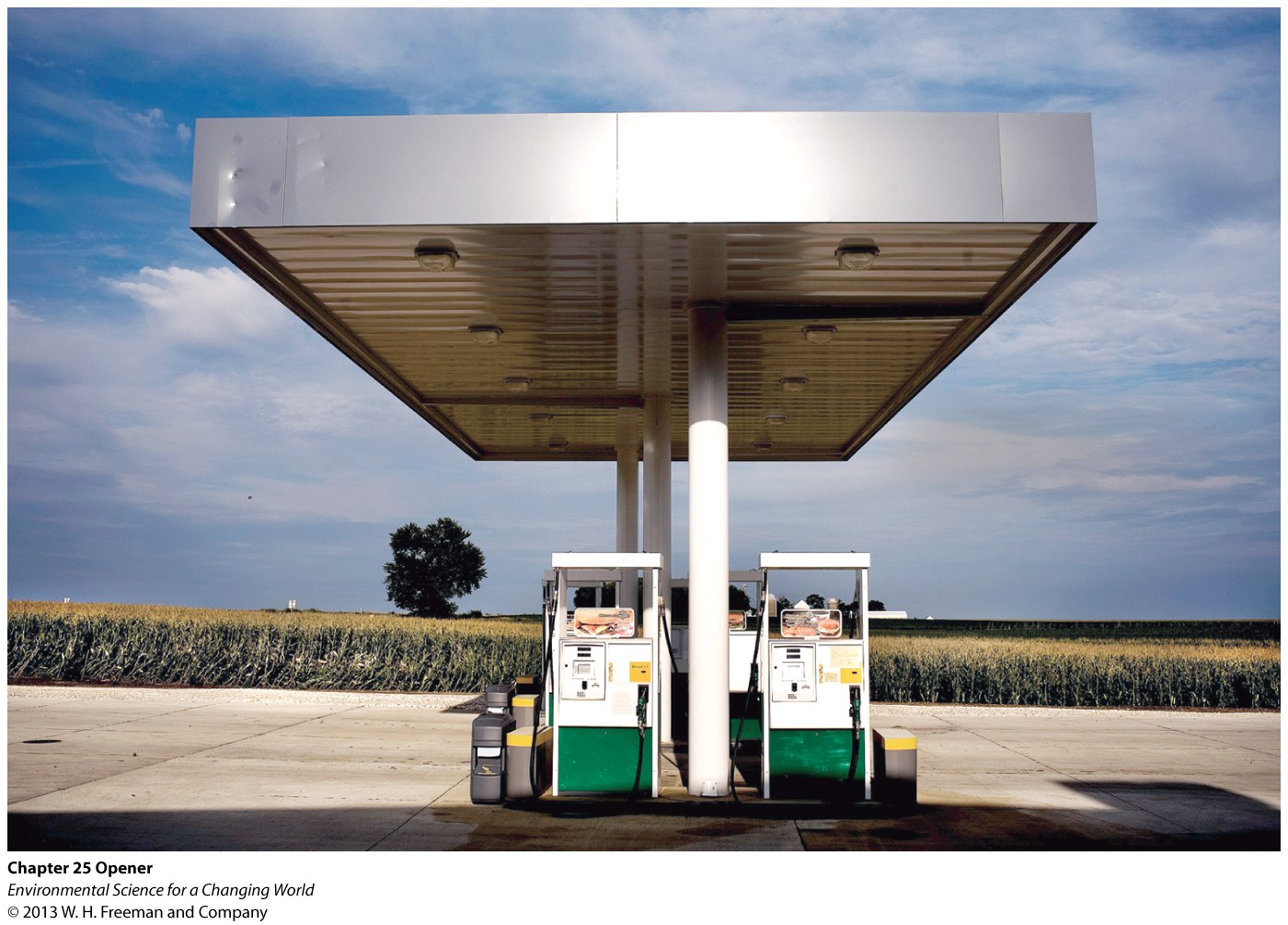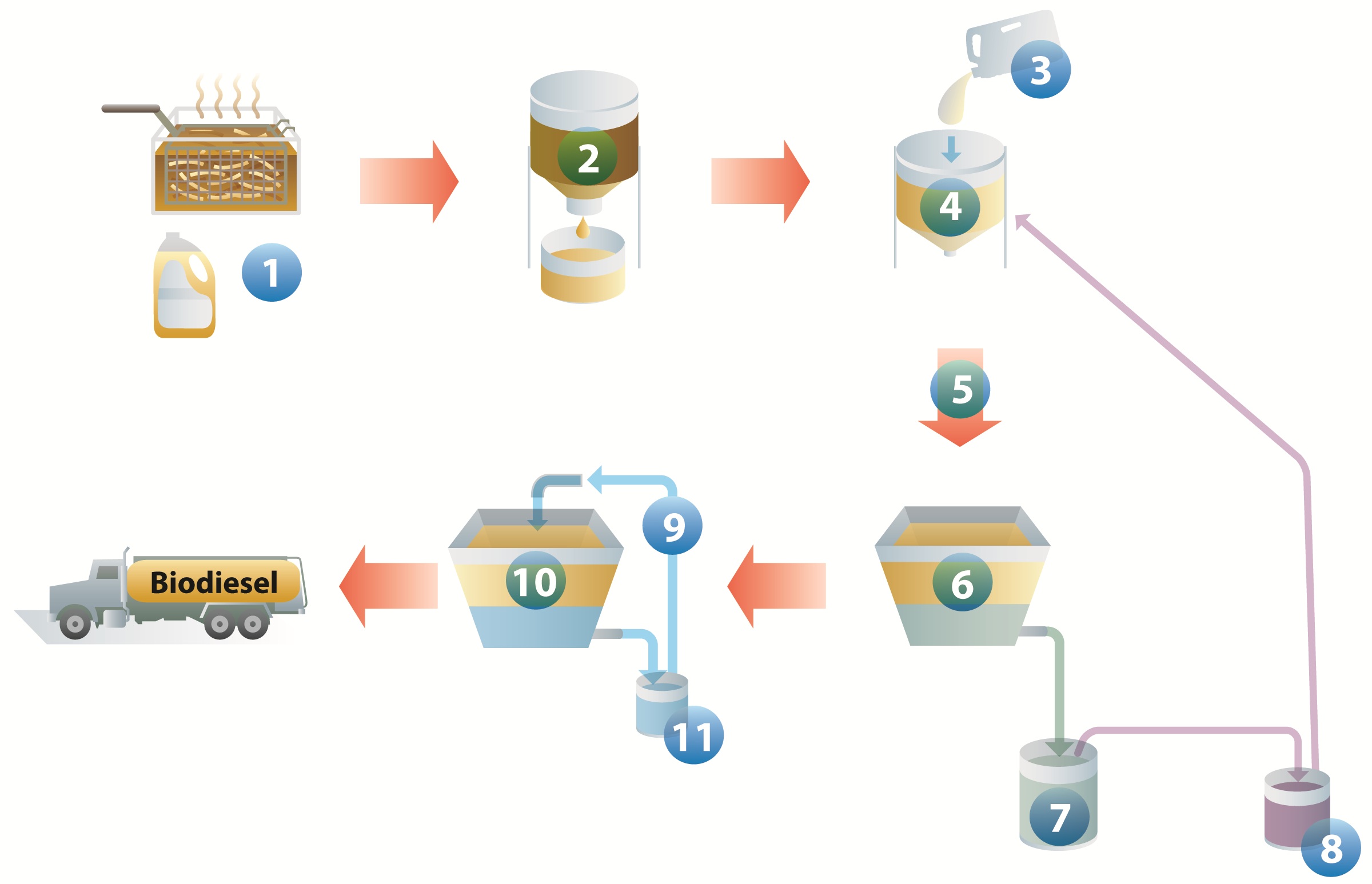Chapter 25. Chapter 25: Biofuels
What are biofuels and what are potential biofuel sources?

Guiding Question 25.1
What are biofuels, and what are potential biofuel sources?
Why You Should Care
Biofuels are "hot" these days because they are currently offering the most promise as a replacement for petroleum-based fuels. A biofuel is, not surprisingly, fuel produced from living organisms. Nearly all such fuel is either produced directly by autotrophs or by yeasts or bacteria fermenting the carbohydrates produced by autotrophs. These fuels can be hydrocarbons, oils, or alcohols, but all share the quality of being able to release a lot of energy when combusted. Many different sources of biofuels are being researched: Algae, grass, corn, and oil palms are just a few examples. One biofuel is already being used commercially: Biodiesel has been available for years as an alternative to petroleum-based diesel fuel. Biodiesel is produced by chemically altering vegetable oil (usually used frying oil reclaimed from restaurants and food manufacturing plants), and can be used interchangeably with diesel in vehicles, machinery, and household oil-furnaces. Although a renewable, carbon-neutral fuel source, biodiesel alone can’t meet the world’s fuel needs because there isn’t enough used vegetable oil. Since it is likely that other biofuels will soon join the market, it is important to be informed about their pros and cons.
Question Test Your Vocabulary
Choose the correct term for each of the following definitions:
| Term | Definition |
|---|---|
| thbCndys2V+cNoINDvjX3SYAnTpgetyi2xDmUYmdlYBHSVz0IdX7yGy4j2sie5xVOwRrdmkI0AP6+RfHqu8VduRerW7hovwquo0CK4IFtC28xEaUtFJ3PQ== | Solids, liquids, or gases that produce energy from biological material. |
| ezEGnkRlE91Ith6gZEeeypqMORuUu8inTm1f7bm5ea01fIGWHIbjOs6kHhf3vcKzllPLOmA1jObSnzGiG8LbmOi0YMI/9ErZchkGCRxUrVSQeawwKFyq9Q== | Plants that live for more than a year, growing and producing seed year after year. |
| SHTICxiOLYuMSMB/96cykNWB7JfmRRoOi+XMTiY8l5Cslc0cIC++sXbC8bd3q8z7CXjfLhkeI+P44dUir26EO5WndZIdsxgF8F8CsgqE9/9CCJiHTdcFpA== | Biomass sources used to make biofuels. |
| Eq4tYLpXwoSFXlJleOR2wZECaEBXPAT8N1wO9jcsLNvk154CJMxwa8EsiM87rNmzMuO5JattimY2UC/nQO3BriOx5us5zX+o+kXQwYUHgR2iGMYifiiDSg== | An alcohol fuel made from crops like corn and sugarcane in a process of fermentation and distillation. |
| A8SPEudr57taJcxsbelUPH5C7mIwh0nGDJ7f5uO6nrtxSaJVkma0h8dU2MsTYtKR6tPkva+39evWjmLnUKc9AxYCIhK+Fsppxe+bwTwmslTLMhh/F7HNoA== | Crops specifically grown to be used to produce biofuels. |
| O2hZPNCJHVx0ZuL5EOJZ/659CTKudPi1ZAriZUPZgHhsyDZzbQ0k/xBRw6RJtkoIGI3EZxpoa0MSXYHINVhPuW5D3q4nQHafWfmH233GKM5WYxREKzECbg== | A liquid fuel made from vegetable oil, animal fats, or waste oil that can be used directly in diesel internal combustion machine. |
| AWEVs3wHG6H1oPNuuQFQ/iVj8XyDrx3BnwvIi27qf9TNK2fC22DAqDuY53oqg32vmXCjQYNcnQLzti9R5DhFS2jhzNCtAjD+3B0v2GrjUozA3WmNgN6DDg== | Plants that live for a year, produce seed, and then die. |
| t6TuY8cds59i9F9ECUqU9Gl0qO/PNN35to3jePmjfi0cRwJXjASy6utcYOzdJiVurlq1YxAi3i98kDEJGRgt39YiNdS6A1F7jPlUovfR65Tex6Nxn7uzgg== | Material from living or recently living organisms or their by-products. |
Question 25.1
5S99UObaQ+FYP5NM5kmn161Qf7bAL6T49NqXj+X4xxaDRDW01VY9GPwphVhC41z4+MeIllQMG1FsfJ6TTAhkpsBRk063tmhj4X/fFQE3VxlFBU8rqFR1Bs2dO11NxisugrhzK0T6mUL5ILtB0/RWYpiHfPJv8oLGep3fl5GhCBZJoDhoFoMyuvK7YqJ0B4YhHNr4vvyvXLiPJhl/Question 25.2
bOJY4vh067dL6Akr1Js0RLHdFg/HQleNwgvBnJjdQpvgAjBcTwvvzBxv+sv5kOdOhk+PtbFKMKCSlkeMjDHxGXNdt0pk/AZ7F7yQ1tYTUGaqGN5BPieAFOpJ6bHSiIycKxJoxWYp//4Cd4B84pdFQvXNw3TOe8E83V8n7+/dKpAC4z1S7G4NbjIX70GCbqHqhKor3Bkx17T/o67w7eLiqXLUa4MXZvTwPfCLEX5cAwQMzDDAswHEC3zuXwIiU1EUgKZDVOcl93Cg3lvI16gJJP8+xA0NXHolpSaYT2HUSQu5JAsyeSQr3q9/TZCsibFyk1HZu+fLlDsNvTYSW4r1axK0gzLXV9X3iHZChkFQ3evY4nLHd7cmlfwkXaotxy54z1wP3Q==Question 25.3
BFywPgvFt6TWVRcGHVE7/1rIpH3XexuKgPoTDBdjSl509DU/5mLpCSs3LSZGIyyw0YerrCseE3TsuwbZfAueimT7akm6ZD9Eti/z7HnIoC3TNCd65JxbFI9qaFJ14ZXETHcSpWKZnS2T5joVsHXp3B13jbyARWnLLf/gt9Zz8YJmPggNc+qLmqnXwRckbYUdRwrOHosQhP9JKapVDmgd/gBAU4Q8yToa95l0b2ZEfLiZUzL2OZ1O0DM3zSe9AOge7YG2nRiXQ3G8UhwJl7WP3U1/fFJmvqwGSW81p97W5xDqIH6CNS5bE2YKgMzzAMb8vx/MBqcU+TivsJ38JR38YCrql6DAA3dBR7gftw==Question 25.4
Bim3KywkT0PLLafXVxX9iuR/bMpoKzQGwVboRjTNd1JmvZPSegZC6RlBJtaSSw0Dyv+0PxGPU3xTfkmWhz5Nx6DQKlCf1X0ediL12RQ3kGCW0SwwNX1kXh6iUEchWecGGt5JzDODy7bFE4iwRT1wRFVQ9RnLRdaQNQWUgH5eqr5xMdmrJ4le5lKh5jDhx+SktzqFPUhrP5xNQCU7zPHIFBqZd1rQT6RXtHU6dq8TuuXQzEbzQuestion 25.5
m/W6iM1rlGeEouy177xGvTxMlXB78abPs4zkubNeAx1T8FxUiVtuaRiN9zishsWCQhsynt19BfBnO01h6/4VU8ZHP8/Nxi9ImWXyQGMnWwdhpLVlVhSVVWwaCioqIGnN5wAg9ejjg2qqsjyBJGPgahBthBjIKjKHkN6PTSStF7yD8+r3Crcxmg==

Question 25.6
kYvL1eqIv8fE4ESrMoLbpb9nQ84K3v/ABSnkCso9V2BOi4gOQFPqFxQr/i2PQ2wQIS0VYFM9QJJabm8A4CMs6beqXuG/+G5F//S61/y32i2sS3Gr+0T+2Jwt5Q2xDawEr0RS1/PW05g0mAO+znod8DOONVI=Match the descriptions below with all of the possible energy sources that fit them:
Question 25.7
Non-edible source that can be used for direct biomass energy and produced expressly for that purpose:
aFyLQOV9P9qF6KzY Wood
6Tla4sTC7UhhcmHA Corn stalks
6Tla4sTC7UhhcmHA Manure
6Tla4sTC7UhhcmHA Switchgrass
Question 25.8
Source that is used both for direct biomass energy as well as for producing biofuels:
aFyLQOV9P9qF6KzY Wood
aFyLQOV9P9qF6KzY Corn stalks
aFyLQOV9P9qF6KzY Manure
6Tla4sTC7UhhcmHA Switchgrass
Question 25.9
Source of biodiesel:
aFyLQOV9P9qF6KzY Soy
6Tla4sTC7UhhcmHA Poplar trees
6Tla4sTC7UhhcmHA Sugarcane
aFyLQOV9P9qF6KzY Sunflowers
Question 25.10
A waste product that is a potential source of cellulose for bioethanol production:
6Tla4sTC7UhhcmHA Poplar trees
aFyLQOV9P9qF6KzY Sawdust from lumber mills
aFyLQOV9P9qF6KzY Corn stalks
aFyLQOV9P9qF6KzY Dead soy bean plants

Question 25.11
cBya4tlRIZCqflK7NiyWaM4aATwhhZbnwlrxfFkooeV53hwH5G8lqcI6xeeSUdjwkes8oJ3StgUAe9sOe2oPAdwUm3j1lYzcXgaaXwAKdQNAJvlY5Xyefe/Z5rbpwAW6/jq2XfR/Ww6UikbfgEaHsCcAfHoQM2DNkpUbY+aUNjhuxEZqvpVUJQaTgpDS8fyOIA+nBzqEgrU=Question 25.12
G0PWEMTMZY+7bV2Incpc+UD860utMu/83Dxsc0fhqL4URaB5u48cFqucEs/4HJKBMUuOG8IzXbQkJOr0RZZdL5RSSypbyi+KE1q584028XzAfyQv52ocdNRcC/pXxnnS13kzFD6uRG6ubox4UWFwT4XiVJPPSpAJzB2BIzYiiBoqrXrLrUn5ldICQgzoF0CDKe0J38mM3RkpLnneCmSk+Qab0ZQuIrFu/6ckW3pAMrvpsmsB9m2DiXA98sfBIpncLAGTIo40xbFxOab7LghCBoiNQXGDVarwnVfcQP8JoAjoX/A2d1j1OZK6lpeQ/hGWoVdf0nUGuUXV1/fNHikiYXec2HkPvVfcoH6EauYB7pid3naiVVnbWYtbtRauTpU2ZfyWax1yLUdSwhhQle8vl9BspxdyKt0ItclOBHrUyNd+GJEVYi9dBAlshNXzdUG/HQe0VjDnwbXCO8oQHq/HZn/vAj6PqVJ8qbrdb0SZagpPUJ+mdKlix3/9M0TZKXyD1qPag2ZhH/Q=Question 25.13
3C3nOVr+9h28kkAJkDMwbLVqUCw+ym6Kt0+jXP1Wa4m4vxlGOxysjSbEZcKvfy6buZopXjtshos3KdQTelIuYhKvZo9QEYrUqk+nNszDNUeTaw3911MPWs5SLjsqCBk9CpzD8OU+9APD94rTu2DpbYxTDGSNT9m9fXXJxeT2XY8QX+KblKnsHFB0hP6ysydQmTbLrdT66UaLtuLec9fEX3b1qrynmgzhv2P/RDKoGSQD90KRk5lchtImVWQ7xr6JdVq52E0ksw/dtXLW7YDqDbsRtw0y6MTwiiHbB5Po4dJKIqMK0f4Ui6KxeQIilp1VDuG6QA==Question 25.14
ZOwc8bBVi0q2pk9ImvlgPW3YxRk2b9qcMW65COz15nUX6Vjy9hKbPHiN99GjSU1BEOR1MkaKLS4pWHIdYP6alWIcoYMvt4SjXXKHWlyw+l+9vmAYGXtkdzuIyTmSJK3y6/jcFAgW0hhpwv3tXBDT2NpozJYj7ca9S37OMiw4VI4AhOhojbHWKu5LMxv/DlDdhMzU2xSoD+ElLh9AqvVs4DFloZgTdZevPw3p6w==
Question 25.15
Select the number in the figure that best corresponds with the items below:
Glycerin: oaws7xH5uFIpbfe9qTg85YaQfghiy4cnLkLT2ilA2zGnVF9Qd0oYzg==
Lye and methanol: jv4lH0JyzQaJmBIG22NDOtFx2xIA+1CF3OszpxWjoKVacGfcEiuk6Q==
Methanol: BZGLAcSm+0S0nqdCYIkWTD6UenQ7x/+6TLZWJ2+XS++aHrSnr78+rw==
Feedstock: 4yyF1jF3qZMp9DFu5MPjYoRatBX6Fhc1yQ+btXeH+jcRIpFssy+QcA==
Water: 9ZJT67LicZvX2ZCVoROxJCRvTFvQMVMgp/VRPN4GyQtLu/1jyM4F+Q==
Pre-processing: w80Alz7KYO9XabN5Ib89dDLPzo1uKJ/sfPOGzRNPBGydvRQvcE0UNg==
Step that includes filtering solids: w80Alz7KYO9XabN5Ib89dDLPzo1uKJ/sfPOGzRNPBGydvRQvcE0UNg==
Washing to remove impurities from biodiesel: VhHy3n51qZ2RWyPEwxWYkPR8qQY96nl3N4iu6BVfaRPko8ZO7U+ISw==
Chemical reaction: ToizPIsgXSslhLX7kxSrbLyY/tgwVAMajOb4wYFJ7q/SbeXXgX2eyg==
By-product that can be sold for other uses: oaws7xH5uFIpbfe9qTg85YaQfghiy4cnLkLT2ilA2zGnVF9Qd0oYzg==
Can be reused for creating fuel: BZGLAcSm+0S0nqdCYIkWTD6UenQ7x/+6TLZWJ2+XS++aHrSnr78+rw==
Can be reused to remove impurities: D6rx4xLq5GrXjimlv/DHt5CalbTGgr0pI2z0HmKmUtw9SYa9u3XHIg==